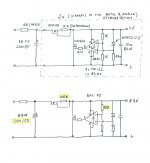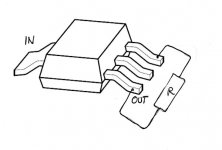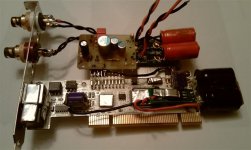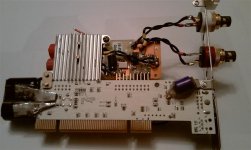I'm trying to get the voltage regulator to working. For some reason the BSP129 Current source does not work. The BSP129 are new but give zero current.
Also tried to connect the gate and source together with 15v at the drain still same problem.
Pin 1 is gate
Pin 2 is drain
Pin 3 is source
Also tried to connect the gate and source together with 15v at the drain still same problem.
Pin 1 is gate
Pin 2 is drain
Pin 3 is source
Attachments
Last edited:
I'm trying to get the voltage regulator to working. For some reason the BSP129 Current source does not work. The BSP129 are new but give zero current.
Also tried to connect the gate and source together with 15v at the drain still same problem.
Pin 1 is gate
Pin 2 is drain
Pin 3 is source
Hi,
If as you suggest here there is is no output after the depletion mosfet, unless the connections are not correctly arranged, this implies that the mosfet is damaged.
This arrangement with a resistor and a depletion mosfet is a text-book implementation for restricting currents, and being so simple and with merely 2 components involved it is difficult to understand how it can go wrong otherwise.
I have been using variations of this circuit for maybe 10 yrs now and never experienced any problems with these mosfets, nor with DN2540 which are also frequently used to regulate currents in a circuit like this.
By way of encouragement, when you overcome the problem I believe you will like the results. For this particular DAC circuit it is the finest-sounding regulator out of a great many I experimented with during the past 4+ yrs, and Peter seems to like the results as well.
I hope that you are able to resolve the problem soon.
Regards,
Hi,
If as you suggest here there is is no output after the depletion mosfet, unless the connections are not correctly arranged, this implies that the mosfet is damaged.
This arrangement with a resistor and a depletion mosfet is a text-book implementation for restricting currents, and being so simple and with merely 2 components involved it is difficult to understand how it can go wrong otherwise.
I have been using variations of this circuit for maybe 10 yrs now and never experienced any problems with these mosfets, nor with DN2540 which are also frequently used to regulate currents in a circuit like this.
By way of encouragement, when you overcome the problem I believe you will like the results. For this particular DAC circuit it is the finest-sounding regulator out of a great many I experimented with during the past 4+ yrs, and Peter seems to like the results as well.
I hope that you are able to resolve the problem soon.
Regards,
Hi Bob,
Thanks for your input. The fets are out of a reel of 50 i tried 2 with the same result. I just connected as followed now: 15v at the Drain, 10ohm between gate and source, then 220ohm from the gate to ground. There is 0Volt over the 220ohm resistor.
If connect the 220ohm resistor at the source and then to the ground. and i hold my finger on the gate then there voltage of around 8volt over the 220ohm.
Can't figure out what the problem is yet.
thanks
Hi Bob,
Thanks for your input. The fets are out of a reel of 50 i tried 2 with the same result. I just connected as followed now: 15v at the Drain, 10ohm between gate and source, then 220ohm from the gate to ground. There is 0Volt over the 220ohm resistor.
If connect the 220ohm resistor at the source and then to the ground. and i hold my finger on the gate then there voltage of around 8volt over the 220ohm.
Can't figure out what the problem is yet.
thanks
Hi,
I don't know why you are trying a resistor from gate to ground as it is not part of this circuit, unless this is intended for a dummy load. You also don't make any mention of installing the other components at this stage, and if these are added you don't need a dummy load because the resistors between output and pin 2 (of the AD811), and pin 2 and ground, are adequate for this.
I suggest that you follow the entire circuit as Peter has shown adding all components (if you haven't already done this, because you don't suggest the other components have been installed yet) and unless the mosfets are damaged which now seems unlikely, the results should be as predicted.
The resistor between gate and source determines the max current, and for circa 8v output which is determined by the ratio of the resistors connected between pin 2 and output/pin 2 and ground this needs to be in the region of 3R for the necessary current and 10R is too high in value here.
Regards,
Hi,
I don't know why you are trying a resistor from gate to ground as it is not part of this circuit, unless this is intended for a dummy load. You also don't make any mention of installing the other components at this stage, and if these are added you don't need a dummy load because the resistors between output and pin 2 (of the AD811), and pin 2 and ground, are adequate for this.
I suggest that you follow the entire circuit as Peter has shown adding all components (if you haven't already done this, because you don't suggest the other components have been installed yet) and unless the mosfets are damaged which now seems unlikely, the results should be as predicted.
The resistor between gate and source determines the max current, and for circa 8v output which is determined by the ratio of the resistors connected between pin 2 and output/pin 2 and ground this needs to be in the region of 3R for the necessary current and 10R is too high in value here.
Regards,
Yeah i used the 220ohm as dummy because i had some problems. The dac is currently not connected until the problem is solved.
Thanks
Hi,
<SNIP>
I have been using variations of this circuit for maybe 10 yrs now and never experienced any problems with these mosfets, nor with DN2540 which are also frequently used to regulate currents in a circuit like this.
By way of encouragement, when you overcome the problem I believe you will like the results. For this particular DAC circuit it is the finest-sounding regulator out of a great many I experimented with during the past 4+ yrs, and Peter seems to like the results as well.
<SNIP>
Bobken,
It was fabulous news to hear that you were still active and even moreso when you started posting again. Anyone interested in optimizing their audio system could take a quick course in how to empirically attack that problem by merely reading the 1000 or so posts you've made over the years. (Of course, Peter D's not to shabby at that either!)
I do have a question for you... the DAC as presented by Peter is balanced, but he notes that you have implemented an un-balanced version. Are there any special implementation notes that you can share for doing an un-balanced version... for example, do you still use two TDA1543 chips similar to what Peter does, but only output from each chip... or do you just use one chip?
I'm looking at doing an I2S-connected version of this for mounting on a Juli@ sound-card's digital section. I've done this with several other DACs with good results... see attached picture of an implementation using DIYAUDIO member EUVL's ES9022 DAC card. This and a number of power supply updates (the computer is powered by linear rather than switch-mode power supplies) have made my computer audio setup sing (at least compared to what it sounded like with a stock computer SMPS)!
I'll probably do a point-to-point implementation of the TDA1543 similar to Peter's... gathering the parts presently.
Again, GREAT to see you here again!
Greg in Mississippi (usetabe Minneapolis)
Attachments
Bobken,
It was fabulous news to hear that you were still active and even moreso when you started posting again. Anyone interested in optimizing their audio system could take a quick course in how to empirically attack that problem by merely reading the 1000 or so posts you've made over the years. (Of course, Peter D's not to shabby at that either!)
I do have a question for you... the DAC as presented by Peter is balanced, but he notes that you have implemented an un-balanced version. Are there any special implementation notes that you can share for doing an un-balanced version... for example, do you still use two TDA1543 chips similar to what Peter does, but only output from each chip... or do you just use one chip?
I'm looking at doing an I2S-connected version of this for mounting on a Juli@ sound-card's digital section. I've done this with several other DACs with good results... see attached picture of an implementation using DIYAUDIO member EUVL's ES9022 DAC card. This and a number of power supply updates (the computer is powered by linear rather than switch-mode power supplies) have made my computer audio setup sing (at least compared to what it sounded like with a stock computer SMPS)!
I'll probably do a point-to-point implementation of the TDA1543 similar to Peter's... gathering the parts presently.
Again, GREAT to see you here again!
Greg in Mississippi (usetabe Minneapolis)
Hi Greg,
I'm not sure that I live-up to your kind comments, but it is always more-encouraging to see some appreciation instead of the frequent 'bashing sessions' which occur on this Forum whenever someone discusses subjective experiences. Just looking at the Blowtorch thread recently confirms that nothing has really changed in spite of personal assurances from Officials here that such intolerance (which in my view amounts to overt bullying in some instances) will be stamped-out.
I am quite capable of holding my own with such oppressive and arrogant members, but in my last years on this earth I don't wish to waste my time in such a negative manner.
For several years I have just avoided the aggravation and unpleasantness entirely by not looking at this Forum at all, but I have been just as active with audio experiments and have kept in touch by private mail with many members including Peter.
Anyway, to answer you question over the number of chips I use, I do simply rely on a single TDA chip for each DAC. This is no criticism of Peter's choice at all, and results from my concerns over simplifying the circuit as much as possible together with my experiences when measuring a large number of these chips. Out of maybe 75 TDA1543s I have yet to find a single one which measures similarly from one channel to the other(!), let alone any 2 chips which match each other very well, and the differences in the distortion characteristics are all too obvious to me on listening trials.
During the past circa 5 yrs I have found perhaps 500 combinations of supporting components which work together well to produce a remarkably enjoyable result sonically using TDA1543s, and probably ten times more than that which don't! This is no exaggeration, and I have around 300 pages of listening-notes written following every change I have made to the original circuit.
All such circuits are subject to certain compromises being necessary during the design/development phase partly because no components are absolutely perfect, but with the 2 main active chips we have (still remaining) in this DAC, there are some serious shortcomings unfortunately.
The CS8412 can be made to 'sound' very good but the necessary associated components are so critical to getting this right, and very small variations especially in the PLL filter can either make or break the sonic results.
The TDA1543 is possibly even more of a challenge but it must be remembered that this was an "Economy version" as originally described by Philips, and we are using this in a manner not really intended by the makers, so it still amazes me that such incredible sonic results can be coaxed from this chip.
Apart from its distortion characteristics which are worsened by our chosen application, and which also vary between channels, the greatest hurdle to overcome in my experience is the limitation in the 'hybrid' PS where both digital and analogue sections of the circuitry are shared. Frankly, this is a technical disaster particularly in my experience because the characteristics and components I prefer to use to obtain the best sonic results are rather different between analogue and digital circuit's power supplies.
Truthfully, I have never come across such a challenging circuit in my 40 odd years of audio tinkerings, but the mere fact that I am still playing around with basically this same combination of CS & TDA chip circuit reflects the number of times when I have been literally stunned by the results which can be achieved.
Previously, I have not attempted to work on any circuit where I was already aware of so many obvious limitations before I started, as I am not a masochist by nature, although I don't generally back-away from challenges in life (and audio!). Additionally, I have never wittingly used any components which were clearly flawed/compromised technically so much, also having satisfied myself through very many years of listening-trials over the sonic benefits (or otherwise!) of virtually all well-known passive devices which have been made.
However, in this instance I simply wished to discover for myself what all the fuss was about with designs using an old chip like the TDA1543, and although I am a minimalist in audio by nature, I had not ventured into the simple chip-type circuits before like so many others had done. I had not previously enjoyed digital reproduction very much in spite of listening to many highly-regarded CD-based systems, I always preferred analogue reproduction, and I was familiar with and also understood analogue circuits quite well.
To this end, and knowing Peter through this Forum, nearly 5 yrs ago (and long after all the excitement with the NOS DAC 'pioneers' had died down) I asked him to send me one of his kits as an easy start into this new arena for me, although I didn't anticipate the results could possibly be quite as impressive as they turned-out to be.
When I started to modify the original circuit, many of my significant discoveries were shared with Peter from time-to-time, and most of them Peter tried-out for himself and agreed that they were improvements, so he adopted them in his circuits. Similarly, Peter advised me of some discoveries which he had made and I would also try these out and mostly agree with his findings. I am sure that there will never be any precise or definitive concensus between us on every component in this circuit due to its quirks which can only partly be overcome, and the fact that we have different music tastes and different ancillaries in our systems.
However, in the main we do seem to agree on the perceived sonic effects/results of carrying-out certain changes, and this corroboration is certainly beneficial and helps with the progress of 'optimising' this particular NOS DAC.
I shouldn't hog Peter's thread too much, but if he doesn't mind perhaps when I have more time to spare I will try and put some more practical notes together based on my many experiments and listening-trials which I have conducted with this intrigueing (and often very frustrating!) circuit.
Regards,
Last edited:
Okay,
so i think i´m in too.
Bob, as i understand, you are just as Peter involved in this
project. Well, the both of you did a real good job. I like
this nonos DAC very much and would be happy if this thread
and bringing the tda one more step ahead will last for some
time.
Thanks and Greetings ulf
so i think i´m in too.
Bob, as i understand, you are just as Peter involved in this
project. Well, the both of you did a real good job. I like
this nonos DAC very much and would be happy if this thread
and bringing the tda one more step ahead will last for some
time.
Thanks and Greetings ulf
Ok... with that encouragement by Peter, I have several questions...
For Bobken... in using this as a guide to creating my I2S-connected soundcard mounted un-balanced TDA1543-based DAC, I see that I only need the TDA1543, it's associated I/V & voltage reference resistors & coupling caps, and a power supply feeding an 8.3v regulator. Anything else?
Also for Bobken... I can safely infer that you have tried a wide number of various regulator schemes in this setup. Have you tried any no-feedback shunt regulators such as the Salas? Have you tried any with cascode current sources? And have you tried any of Paul Hynes' units?
Then for Peter... I assume that copying the refined CS8412 circuit shown in this thread along with the updated regulator and removing the SN75179 be a useful upgrade to my AS NOS DAC kit, along with the TDA1543 upgrades I described above. Correct? I am intending keeping the circuit in an un-balanced mode for now.
And finally for Peter (and possibly Bobken)... have you tried the AD811-based shunt regulator in your phono circuit?
TIA all!
Greg in Mississippi
For Bobken... in using this as a guide to creating my I2S-connected soundcard mounted un-balanced TDA1543-based DAC, I see that I only need the TDA1543, it's associated I/V & voltage reference resistors & coupling caps, and a power supply feeding an 8.3v regulator. Anything else?
Also for Bobken... I can safely infer that you have tried a wide number of various regulator schemes in this setup. Have you tried any no-feedback shunt regulators such as the Salas? Have you tried any with cascode current sources? And have you tried any of Paul Hynes' units?
Then for Peter... I assume that copying the refined CS8412 circuit shown in this thread along with the updated regulator and removing the SN75179 be a useful upgrade to my AS NOS DAC kit, along with the TDA1543 upgrades I described above. Correct? I am intending keeping the circuit in an un-balanced mode for now.
And finally for Peter (and possibly Bobken)... have you tried the AD811-based shunt regulator in your phono circuit?
TIA all!
Greg in Mississippi
The more hogging, the better
O.K. Given the green light now, I'll do a bit more 'hogging' as time permits but having returned from a holiday this past weekend I do have some catching-up to attend to, so it may take a while.
Ulf, to make the position clear I had nothing to do with the original design which was Peter's entirely, and not being enamoured of digital audio before using this DAC, my *digital circuit* experiences were limited to general repairs and upgrades to various pieces of digital equipment, mostly belonging to others.
Previously, I had always been very much an 'analogue' enthusiast and I have spent over 40yrs designing, modifying, and developing analogue circuits, especially through minimising unnecessary components wherever possible, and selecting all components I used through dedicated listening-trials/comparisons.
Since I commenced the upgrading experiments on this circuit of Peter's I have carried-out the majority of the tedious 'leg-work' required, and I like to think that my enthusiasm and consequent results perhaps also inspired Peter to take this circuit several stages further along the road towards sonic perfection. Peter kindly acknowledged my contributions at the start of this thread, and it should be known that I am in a more-fortunate position than most (being retired for some years) and am therefore able to spend a lot of my time on audio 'development' exercises like these.
These can be inordinately time-consuming anyway, but with this not-straightforward circuit I have found that it takes a lot of patience and understanding to achieve real improvements, mainly because so much has already been achieved by many others before me.
A lot of earlier work had gone into these TDA NOS DACs long before my own involvement, so around 5yrs ago when I first constructed Peter's kit it was already a very good-sounding DAC without any doubt, and I shouldn't take any credit away from him for that now.
Previously, I had some of my equipment used for demonstration purposes by another Hi-Fi manufacturer at the UK's then most prestigeous annual Audio Show at Heathrow in London, and I became (originally unintentionally!) involved in designing some electronics commercially at about the same time as my initial interest in Peter's NOS DAC kit. A side-benefit of this was that I was able to try a lot of high-end audio gear both together, and in direct comparisons, with my own personal domestic audio set-up equipment. At that time apart from digital audio reproduction (i.e. CDs) I was entirely satisfied with my own equipment, and after spending over 40 yrs optimising it, I really should have been!
Regrettably, none of the 'high-end' alternative digital equipment I listened-to inspired me to accept CD as a serious alternative to analogue reproduction during this period, but I had become enchanted with some of the extraordinary results I was experiencing with this NOS DAC, even though I could readily hear certain sonic deficiencies or shortcomings.
The inevitable result was that I decided that I should make the effort myself to see if I could improve on what others had already achieved. I think Peter will probably agree that this spawned the idea of taking this DAC circuit to the extreme limits, no matter how long it took nor whatever work was involved in dong this, although this wasn't actually discussed at that time. Matters rather evolved as time went by, and as Peter already said what began as a trivial discourse between us has blossomed into nearly 5yrs of swapping experiences and has resulted in this further development work on the DAC.
Regards,
- Home
- More Vendors...
- Audio Sector
- Pushing the limits of TDA1543 NOS DAC



